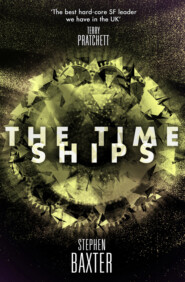По всем вопросам обращайтесь на: info@litportal.ru
(©) 2003-2025.
✖
Space
Автор
Год написания книги
2018
Настройки чтения
Размер шрифта
Высота строк
Поля
Malenfant stared around at the rows of Japanese faces, like coins shining in this rich brown dark. They seemed remote, unreal. Many of these people were NASDA administrators; as far as he could tell there was nobody from Nishizaki senior management here, nominally his sponsors for the trip.
The virtual was a simple schematic of stars, randomly scattered. One star blinked, representing the sun.
Malenfant said, ‘We will launch unmanned probes.’ Ships, little dots of light, spread out from the toy sun. ‘We might use ion rockets, solar sails, gravity assists – whatever. The first wave will be slow, no faster than we can afford. It doesn’t matter. Not in the long term.
‘The probes will be self-replicating: Von Neumann machines, essentially. Universal constructors. Humans may follow, by such means as generation starships. However it would be cheaper for the probes to manufacture humans in situ, using cell synthesis and artificial womb technology.’ He glanced over the audience. ‘You wish to know if we can build such devices. Not yet. Although your own Kashiwazaki Electric has a partial prototype.’
At that there was a stir of interest, self-satisfied.
As his virtual light-show continued to evolve, telling its own story, he glanced up at the walls around him, at the glimmer of highlights from wood. This was a remarkable place. It was the largest structure in Edo, serving as community centre and town hall and showpiece, the size of a ten-storey building.
But it was actually a tree, a variety of oak. The oaks were capable of growing to two hundred metres under the Moon’s gentle gravity, but this one had been bred for width, and was full of intersecting hollowed-out chambers. The walls of this room were of smooth polished wood, broken only subtly by technology – lights, air vents, virtual display gear – and the canned air here was fresh and moist and alive.
In contrast to the older parts of Edo – all those clunky tunnels – this was the future of the Moon, the Japanese were implicitly saying. The living Moon. What the hell was an American doing here on the Moon, lecturing these patient Japanese about colonizing space? The Japanese were doing it, patiently and incrementally working.
But – yes, incrementally: that was the key word. Even these lunar colonists couldn’t see beyond their current projects, the next few years, their own lifetimes. They couldn’t see where this could all lead. To Malenfant, that ultimate destination was everything.
And, perhaps, Nemoto and her strange science would provide the first route map.
The little probe-images had reached their destination stars.
‘Here is the heart of the strategy,’ he said. ‘A target system, we assume, is uninhabited. We can therefore program for massive and destructive exploitation of the system’s resources, without restraint, by the probe. Such resources are useless for any other purpose, and are therefore economically free to us. And so we colonize, and build.’
More probes erupted from each of the first wave of target stars, at greatly increased speeds. The probes reached new targets; and again, more probes were spawned, and fired onwards. The volume covered by the probes grew rapidly; it was like watching the expansion of gas into a vacuum.
He said, ‘Once started, the process is self-directing, self-financing. It would take, we think, ten to a hundred million years for the colonization of the Galaxy to be completed in this manner. But we must invest merely in the cost of the initial generation of probes. Thus the cost of colonizing the Galaxy will be less, in real terms, than that of our Apollo program of fifty years ago.’
His probes were now spreading out along the Galaxy’s spiral arms, along lanes rich with stars. His Japanese audience watched politely.
But as he delivered his polished words he thought of Nemoto and her tantalizing hints of otherness – of a mystery which might render all his scripted invective obsolete – and he faltered.
Trying to focus, feeling impatient, he closed with his cosmic-destiny speech. ‘… This may be a watershed in the history of the cosmos. Think about it. We know how to do this. If we make the right decisions now, life may spread beyond Earth and Moon, far beyond the solar system, a wave of green transforming the Galaxy. We must not fail …’ And so on.
Well, they applauded him kindly enough. But there were few questions.
He got out, feeling foolish.
The next day Nemoto said she would take him to the surface, to see her infrared spectroscopy results at first hand.
They walked through the base to a tractor airlock, and suited up once more. The infrared station was an hour’s ride from Edo.
A kilometre out from Edo itself, the tractor passed one of the largest structures Malenfant had yet seen. It was a cylinder perhaps a hundred and fifty metres long, ten wide. It looked like a half-buried nuclear submarine. The lunar surface here was scarred by huge gullies, evidently the result of strip-mining. Around the central cylinder there was a cluster of what looked like furnaces, enclosed by semi-transparent domes.
‘Our fusion plant,’ Nemoto said. ‘Edo is powered by the fusion of deuterium, the hydrogen isotope, with helium-3.’
Malenfant glared out with morbid interest. Here, as in most technological arenas, the Japanese were way out ahead of Americans. Twenty per cent of the US’s power now came from the fusion of two hydrogen isotopes, deuterium and tritium. But hydrogen fusion processes, even with such relatively low-yield fuel, had turned out to be unstable and expensive: high-energy neutrons smashed through reactor walls, making them brittle and radioactive. The Japanese helium-3 fusion process, by contrast, produced charged protons, which could be kept away from reactor walls with magnetic fields.
However, the Earth had no natural supply of helium-3.
Nemoto waved a hand. ‘The Moon contains vast stores of helium-3, locked away in deposits of titanium minerals, in the top three metres of the regolith. The helium came from the sun, borne on the solar wind; the titanium acted like a sponge, soaking up the helium particles. We plan to begin exporting the helium to Earth.’
‘I know.’ The export would make Edo self-sufficient.
She smiled brightly, young and confident in the future.
Out of sight of Edo, the tractor passed a cairn of piled-up maria rubble. On the top there was a sake bottle, a saucer bearing rice cakes, a porcelain figure. There were small paper flags around the figure, but the raw sunlight had faded them.
‘It is a shrine,’ Nemoto explained. ‘To Inari-samma. The Fox God.’ She grinned at him. ‘If you close your eyes and clap your hands, perhaps the kami will come to you. The divinities.’
‘Shrines? At a lunar industrial complex?’
‘We are an old people,’ she said. ‘We have changed much, but we remain the same. Yamato damashi – our spirit – persists.’
At length the tractor drew up to a cluster of buildings set on the plain. This was the Nishizaki Heavy Industries infrared research station.
Nemoto checked Malenfant’s suit, then popped the hatch.
Malenfant climbed stiffly down a short ladder. As he moved, clumsily, he heard the hiss of air, the soft whirr of exoskeletal multipliers. These robot muscles helped him overcome the suit’s pressurization and the weight of his tungsten anti-radiation armour.
His helmet was a big gold-tinted bubble. His backpack, like Nemoto’s, was a semi-transparent thing of tubes and sloshing water, six litres full of blue algae that fed off sunlight and his own waste products, producing enough oxygen to keep him going indefinitely. In theory.
Actually Malenfant missed his old suit: his Space Shuttle EMU, Extravehicular Mobility Unit, with its clunks and whirrs of fans and pumps. Maybe it was limited compared to this new technology. But he hated to wear a backpack that sloshed, for God’s sake, its mass pulling him this way and that in the low gravity. And his robot muscles – amplifying every impulse, dragging his limbs and tilting his back for him – made him feel like a puppet.
He dropped down the last metre; his small impact sent up a little spray of dust, which fell back immediately.
And here he was, walking on the Moon.
He walked away from the tractor, suit whirring and lurching. He had to go perhaps a hundred metres to get away from tractor tracks and footsteps.
He reached unmarked soil. His boots left prints as crisp as if he had stepped out of Apollo 11.
There were craters upon craters, a fractal clustering, right down to little pits he could barely have put his fingertip into, and smaller yet. But they didn’t look like craters – more like the stippling of raindrops, as if he stood in a recently ploughed and harrowed field, a place where rain had pummelled the loose ground. But there had been no rain here, of course, not for four billion years.
The sun cast brilliant, dazzling light. Otherwise the sky was empty, jet black. But he was a little surprised that he had no sense of openness, of immensity all around him, unlike a desert night sky at home. He felt as if he was on a darkened stage, under a brilliant spotlight, with the walls of the universe just a little way away, just out of view.
He looked back at the tractor, with the big red sun of Japan painted on its side. He thought of a terraformed Moon, of twin blue worlds. He felt tears, hot and unwelcome, prickle his eyes. Damn it. We were here first. We had all this. And we let it go.
Nemoto waited for him, a small figure on the Moon’s folded plain, her face hidden behind her gold-tinted bubble of glass.
She led him into the cluster of buildings. There was a small fission power plant, tanks of gases and liquids. A living shelter was half-buried in the regolith.
The centre of the site was a crude cylindrical hut, open to the sky, containing a battery of infrared sensors and computer equipment. The infrared detectors themselves were immersed in huge vessels of liquid helium. Robots crawled between the detectors, monitoring constantly, their complex arms stained by Moon dust.
Nemoto walked up to a processor control desk. A virtual image appeared, hovering over the compacted regolith at the centre of the hut. The virtual was a ring of glistening crimson droplets, slowly orbiting.
Nemoto said, ‘Here is a summary of my survey of the asteroid belt. Or “belts”, I should say, for there are gaps between the sub-belts – the Kirkwood gaps, swept clear by resonances with Jupiter’s gravity field.’ The Kirkwood gaps were dark bands, empty of crimson drops. ‘Of course Nishizaki Heavy Industries is very interested in asteroids. There is a mine in Sudbury, Ontario, which for a long time was a rich source of nickel. The nickel seam is disc-shaped. It is almost certainly the scar of an ancient asteroid collision with the Earth.’
‘Mineral extraction, then.’











